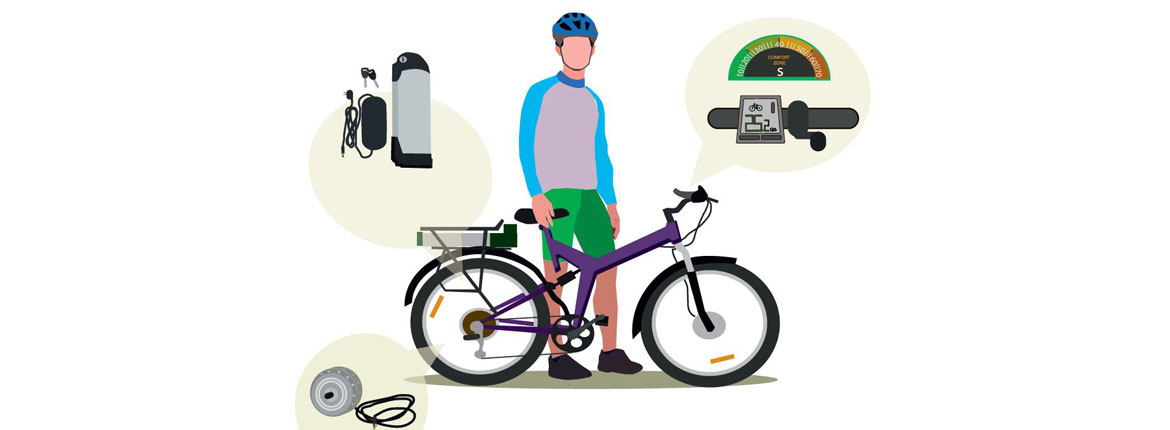
E-bikes: Making the switch
Chris van Ryn looks into the pros and cons of turning pedal bikes electric.
A classic Gazelle bicycle from the Netherlands moves without the need to pedal, purring as it glides gracefully along the streets of Wellington.
The purr comes from a wheel-mounted electric hub motor. This Gazelle belongs to Peter Irwin, passionate cyclist and aficionado of fine bicycles. The Gazelle has been converted from classic bike to classic e-bike with an artist’s craftsmanship.
“When I started the process of converting my Gazelle to electric in 2011, I wanted it to be discreet,” says Peter.
“We mounted the motor in the hub of the wheel and I’ve got leather side bags where the battery hides.
“To install the hub motor, we had to dismantle and re-spoke the front wheel. We installed caliper brakes and I imported a dynamo, like we used as kids, to power the lights. By the time we were done, I didn’t get much change out of $5,000.”
E-bikes are increasingly popular in New Zealand. They suit the sweat-averse commuter, those not quite fit enough to manage steep inclines, the carbon conscious, or those who just ride for fun, hitting the mountain bike trails or catching the breeze along the waterfront.
If you have an existing bicycle that’s gathering dust in a shadowy corner of your garage, converting to electric may be
the catalyst for getting back on two wheels.
For Emma McInnes, converting a brand new Linus bicycle was inspired by becoming a member of Generation Zero, an advocacy group that looks to reduce carbon pollution through smarter transport, liveable cities and fossil fuel independence.
“It gave me the inspiration to start cycling,” Emma says.
“I did a conversion because I wanted a bike that I found aesthetically pleasing and would become an extension of myself. The Linus is a fashion thing. I’m really happy with it – and I’ve inspired five or six friends to get bikes and electric conversion kits.”
There are a few things to know about conversions. While you can buy motors and batteries from a bewildering array of online global outlets, it’s recommended that you purchase your motor and battery through a cycle shop and have them fitted by a cycle mechanic.
Unless you’re an advanced tinkerer, you’ll benefit from mechanical know-how on where to mount the battery and what type of motor best suits your bicycle and cycling needs.
Cycle shops can also assess whether your current bike is sturdy enough to handle the additional demands of an
electric bike.
“Cycle mechanics will typically take two to three hours, depending on the complexity of the job and the bicycle,” Bicycle Junction’s Dan Mikkelsen says.
A hub motor takes longer to fit than a mid-drive motor, as it requires re-spoking.
Hub mounted? Mid-drive?
A hub motor sits in the centre of either the front wheel or rear wheel. The effect is to be either pulled or pushed along. A mid-drive sits between the pedals.
A hub motor is reliable, requiring little or no maintenance. It suits commuters who want a no-fuss e-bike.
A pedal sensor calibrates the motor to your pedal power. If you ease off, so does the motor. If you pedal harder, the motor works harder. Hub motors have larger batteries and consume more energy than mid-drive motors.
Low and centred, a mid-drive is better for a bike’s balance.
It’s efficient and lightweight, uses smaller batteries and goes further than a hub motor. Sensors inside the motor measure speed, torque and cadence.
Mid-drives have great torque, suit hilly terrain and are often used on mountain bikes. Mid-drive conversions are increasingly preferred in New Zealand.
Another thing to be mindful of: The New Zealand Transport Agency classifies e-bikes with 300-watt motors as low-powered vehicles that do not require registration, but 500-watt motors (often used for powering heavier bikes such as cargo bikes) can incur road user fees similar to mopeds.
Babu Platt fitted a 500-watt mid-drive to a Bullitt from Denmark’s legendary cargo bike manufacturers Larry vs Harry.
“I use the cargo bike to do whatever I’d do with a car – mostly grocery shopping. I’m part of a community garden, so I’ll be ferrying kilos of potatoes and tools, going from one garden to the other. And it makes it easier not to carry things on your back. It’s a bit like having a car boot. You just drop things in the box. A cargo bike is just perfect,” Babu says.
It’s clear that he is enamoured with the electric bike culture.
“Once you have a motor, there’s no reason not to ride. And riding an e-bike is so much more fun than riding a normal bike. It’s like having wings. It’s this little parenthesis in your day when you are having fun.”
But not everybody is as enamoured with retrofitting bicycles.
“Converting to electric is not always the smooth process presented by conversion kit manufacturers,” Maurice Wells from EBH Bikes in Auckland says.
“There are several reasons why converting an existing bike to electric is not ideal. The tyres and brakes are often unsuited to the additional demands.
“Or it could be something little, like an integrated lighting system or your kickstand no longer suits the weight distribution of the electric bike, so it always falls over.
“For us,” Maurice says, “a conversion doesn't pass the basic foundation of good commerce – knowing what you're going to buy. You’ve purchased the hardware, done the conversion and the first time you try the bike, you’re already committed. I have people come in with a perfectly good bike, saying they’re interested in a conversion, and I can't tell them how well it will handle.”
But conversions are part of a growing culture of distinctive e-bikes that will continue to add colour and personality to our two-wheeled landscape.
Reported by Chris van Ryn for our AA Directions Summer 2018 issue
